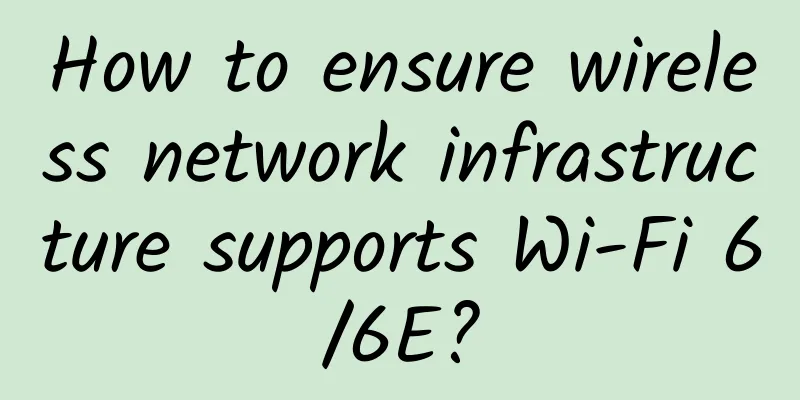How to ensure wireless network infrastructure supports Wi-Fi 6/6E?

|
As the use of wireless devices continues to soar in today's hyper-connected world, the FCC recently released 1200 MHz (1.2 GHz) of spectrum for unlicensed use in the 6 GHz band, greatly expanding the amount of bandwidth available to Wi-Fi and other unlicensed technologies. For industry and consumers, this next step in the evolution of wireless networks not only accelerates the growth of the Internet of Things (IoT), but also promises less interference and lower latency, ultimately meaning higher performance and faster speeds. The wireless coverage of the 6 GHz band is similar to that of the 5 GHz band, so leading access point (AP) vendors say that 5 GHz technology has been established without the need to further increase the number of APs, change AP locations, or re-perform wireless site surveys for environments with the 5 GHz band. But that doesn’t mean the change is without consequence. While the number and placement of APs don’t need to change, the cabling infrastructure that connects them together must be prepared to support the higher throughput capabilities of Wi-Fi 6/6E. Likewise, because industry standards now also recommend uplink capacity of at least 25 Gbps in fiber backbone infrastructure to support increasing Wi-Fi 6/6E traffic and higher speeds, it is more important than ever to follow industry standards and best practices when designing and deploying next-generation wireless network infrastructure. Wi-Fi 6/6E Infrastructure ChecklistGiven the breadth of impending wireless connectivity, wireless APs are now deployed in a wider range of controlled and uncontrolled environments and spaces. Given that they are critical network endpoints in today’s digital world, these devices must be deployed in a way that optimizes coverage while meeting unique and often critical requirements for protection, security, accessibility, code compliance, and aesthetics. So, consider the following as you take your next steps: CoverageTo optimize coverage, wireless APs, by their very nature, must be oriented to provide the best line of sight and avoid being blocked by building structures. Therefore, it is critical to deploy them at the proper location and height without being obstructed by wall panels, ceilings, joists, and other ceiling components. Harsh EnvironmentFor outdoor, near-building deployments, it is important to protect wireless APs from the elements such as rain, snow, sun, and extreme temperatures. Per FCC rules, in the 6 GHz band, only APs designed for outdoor operation may operate outdoors. SafetyProtecting wireless devices from theft, vandalism, and accidental damage is critical in open locations such as schools, hospitals, and other public places. Wireless AP enclosures in these areas should include locking mechanisms to prevent unauthorized access to the device and supporting infrastructure and comply with regulations such as the Health Insurance Portability and Accountability Act (HIPAA). Comply with regulationsSpecific types of spaces may have regulatory requirements that need to be met when deploying wireless APs. For example, hospitals and healthcare facilities need to follow an infection control risk assessment (ICRA) procedure to protect patients from any consequences of routine maintenance or major renovation and construction projects in a healthcare environment. aestheticsMany commercial buildings are designed to high architectural standards and ceilings and walls must remain aesthetically pleasing. In these cases, wireless designers must plan to meet architectural preferences while also ensuring that wireless APs remain exposed to maintain better coverage. Installation NotesIn addition to mounting wireless APs horizontally on ceilings or walls to maintain optimal coverage, the proliferation of wireless communications may require that wireless APs be installed in unique locations, such as outdoor environments and/or beneath seats in large sports stadiums. By keeping these considerations in mind, you will be prepared to address the most pressing Wi-Fi 6/6E needs and make smart, future-proof decisions as the market further evolves. |
<<: What does Wi-Fi bring to Matter’s push for home IoT?
>>: RabbitMQ communication model routing model
Recommend
OneTechCloud: 20% off all VPS hosting, starting from 25 yuan/month, Hong Kong CN2&CMI/US CN2 GIA&9929 dual ISP optional
OneTechCloud was founded in 2019 and mainly provi...
V5.NET: Hong Kong CN2 server 625 yuan/month, 2*E5-2630L/32GB/1TB SSD/10M CN2 line
V5.NET has released a special promotional model, ...
10 ways to improve Wi-Fi signal when surfing the Internet
[[265727]] Slower browsing speeds, no streaming, ...
RackNerd: Multi-room AMD Ryzen+DDR4+NVMe series VPS is available for purchase starting at $14.18 per year
RackNerd is a foreign hosting company founded in ...
Clouveo: $3.5/month KVM-1GB/15G NVMe/2TB/Los Angeles Data Center
You may not be familiar with Clouveo. It is a sit...
Facing these possible accidents, is your operation and maintenance team ready?
With a loud bang, the data center collapsed The d...
Google and Qualcomm join forces to fight against Apple. Will the global 5G competition landscape be further changed?
(Original title: Google and Qualcomm join forces ...
The Trump administration changes its policies overnight: the study visa rules are changed back to the old ones, and the new policy was aborted in less than a week
This article is reprinted with permission from AI...
In the era of 5G, it is not only about internet speed and mobile phones, but you have also overlooked these
[[393747]] When it comes to 5G, is your first rea...
Five ways edge computing drives digital business
Every industry has created a new normal: if your ...
CommScope’s Viewpoint: Operators’ Network Efficiency Transformation in the 5G Era
Despite the impact of the "black swan" ...
HostKvm Hong Kong B Zone 40% off, $5.1/month KVM-2G memory/40G hard disk/1Gbps bandwidth
HostKvm is a Hong Kong VPS provider founded in 20...
Gigsgigscloud Christmas first month 80% off, Los Angeles VPS first month starting from $1
It's been a long time since there's been ...
[11.11] Maxthon Hosting 6.8% off, US/Korea/Japan/Hong Kong VPS monthly payment starts from 34 yuan, top up 660 yuan and get 110 yuan
Aoyoyun also announced this year's Double 11 ...
5G packages are expensive, and you can't afford to change to a 5G phone? In fact, you can connect to 5G without a 5G package
In October 2019, I wrote an article saying that i...








![[Black Friday] HawkHost virtual hosts up to 35% off, reseller hosts/cloud servers up to 30% off](/upload/images/67cac23f66265.webp)
